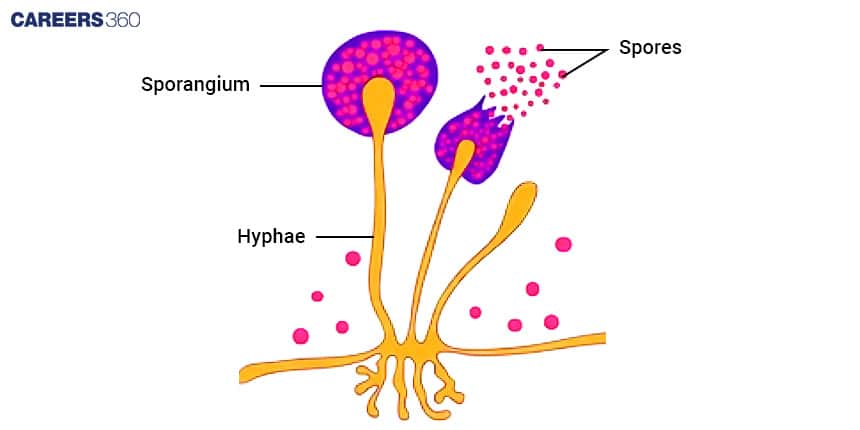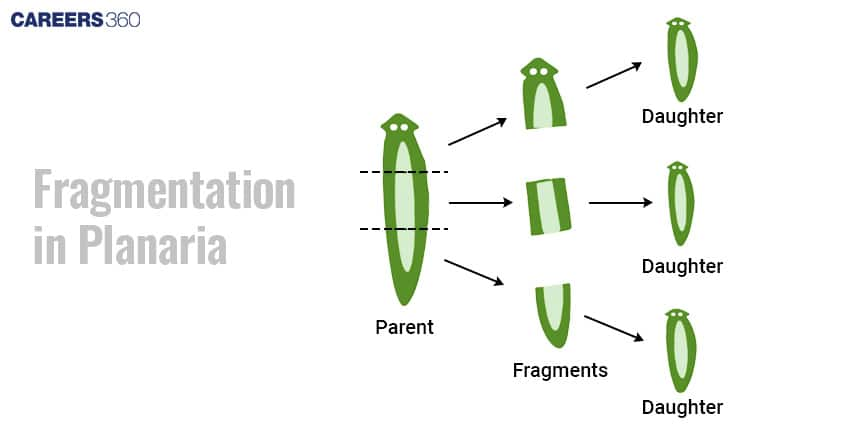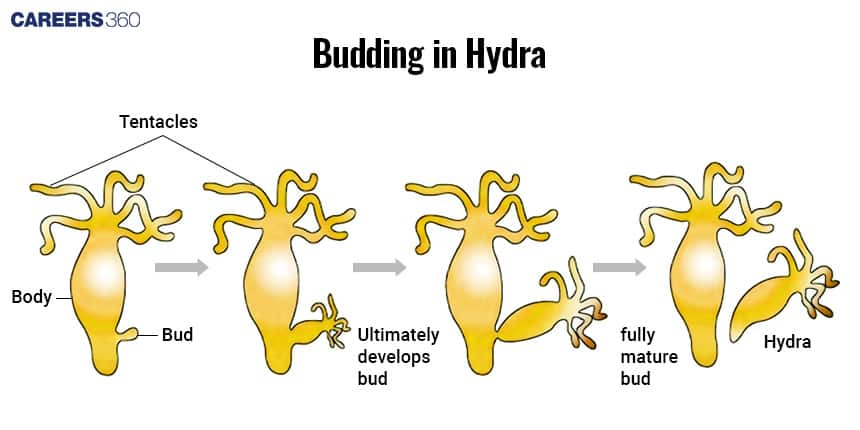Asexual Reproduction - Advantages & Examples
In biological terms, reproduction refers to the production of offspring from an organism and is vital in the transfer of genetic material from one generation to another. It is categorised into two types: asexual and sexual types. This topic is included in the Class 12 chapter Reproduction of Biology. It is essential in understanding reproductive mechanisms, reproduction health, and the associated processes both in plants and animals. Questions from this chapter appear in competitive exams like NEET, AIIMS, and paramedical.
NEET 2025: Mock Test Series | Syllabus | High Scoring Topics | PYQs
NEET Important PYQ's Subject wise: Physics | Chemistry | Biology
New: Meet Careers360 B.Tech/NEET Experts in your City | Book your Seat now
- Reproduction Definition
- Advantages of Asexual Reproduction
- Disadvantages of Asexual Reproduction
- Examples of Asexual Reproduction
- Tips, Tricks and Strategies to Study Asexual Reproduction Modes for Exams
- Recommended Video on Asexual Reproduction
Reproduction Definition
Reproduction is the basic biological process underlying the generation of new life by living organisms to produce offspring, continuing their species. It covers all mechanisms by which living organisms allow genetic material to pass from one generation to another.
This, therefore, means that the importance of reproduction is in the survival and evolution of species. Without the process, species would go extinct because it replaced individuals in the population and ensured the continuity of genes through desirable traits. Generally, reproduction can adopt two basic forms: asexual and sexual reproduction. In asexual reproduction, there is a single parent, and the offspring derived are genetically identical. In sexual reproduction, there are two parents, and the kinds of offspring produced are genetically diverse.
Read More:
Asexual Reproduction
A method of reproduction that involves a single organism and gives rise to offspring with a replica of the parent's genetic material.
Only one organism is needed to reproduce; there are no gametes involved in the process.
The offspring is an exact genetic replica of the parent and identical; variation does not exist.
Asexual reproduction is quick and hence, there is rapid growth in the population.
Asexual Reproduction Types in Plants
The most common natural method of asexual reproduction is vegetative propagation. In this, new plants are formed from parts of the plants such as roots, stems, and buds. Such plants include jasmine and rose, among others. Vegetative propagation can be induced either naturally or artificially.
Components of Vegetative Propagation
Runners: These are above-the-ground horizontal stems found in plants. They have nodes, with buds formed at them, which develop into new plants.
Artificial Asexual Reproduction in Plants
Some of the artificial methods of plant reproduction include;
Cutting
In this method, a portion of a plant such as a stem or leaf is cut and placed in soil. Watering the soil, the underground portion of the plant develops into another plant. It is one of the easiest and cheapest means of asexual reproduction.
Grafting
Grafting requires only the grafting of two very different plants. The two plants are tied together with a thread and are then planted in the ground. As time goes by, they grow like one but have traits from both parent plants.
Asexual Reproduction in Other 0rganisms
The various modes of asexual reproduction in other organisms are:
Binary Fission
Binary fission is a form of asexual reproduction in the organism called amoeba. The totality of the body undergoes mitosis, which is also referred to as equational division, and splits into two daughter cells. There are two steps that occur in the process:
- Karyokinesis: Nuclear division
- Cytokinesis: Cytoplasmic division

Sporulation
In this process, the nuclear membrane disappears, and blocks of chromatin move into the cytoplasm. These blocklets grow into small nuclei and eventually into spores, which mature at suitable conditions to produce new offspring.

Fragmentation
In fragmentation, an organism breaks into fragments, and each piece develops into a whole new individual. In fact, Spirogyra, an alga, can regrow from any cut or broken fragment and functions as an independent cell.

Budding
In budding, a new organism develops from bud formation on some part of an old one.
In budding, a new organism grows from a small projection or bud on the parent organism. This bud detaches and forms a new individual. This method is common in plants such as potatoes. For example, when potatoes are stored, they grow tiny growths called "eyes." When these are planted, they grow into new potato plants.

Regeneration
In regeneration, the parts can develop to form a whole organism, and organisms can regenerate lost parts. The best example is that of planaria. These are flatworms whose body parts may regenerate to form a complete organism with the part that has been lost.
Advantages of Asexual Reproduction
- No requirement for mates, which complicated the process of reproduction.
- Rapid reproduction leads to an increase in the population within a very short period.
- Production of large numbers of offspring in a short period.
- Positive genetic traits are passed to subsequent generations.
- The process might take place through varied environmental conditions.
Disadvantages of Asexual Reproduction
- The offspring is more susceptible to diseases and changes in the environment with limited genetic diversity.
- Diversity is limited among organisms due to participation from only one parent.
- The ability to adapt to changing environments is challenging and therefore poses a threat to survival.
- A change in one environmental factor can wipe out the entire population of a given organism.
Examples of Asexual Reproduction
- Bacteria reproduce using binary fission wherein the cell divides into two along with the nucleus.
- Blackworms or mudworms reproduce through fragmentation.
- Hydras reproduce by budding.
- Some reptiles like copperheads can reproduce by parthenogenesis.
- Sugarcane can be propagated through vegetative propagation.
Tips, Tricks and Strategies to Study Asexual Reproduction Modes for Exams
Here are some tips and tricks to study modes of asexual reproduction:
Binary Fission (e.g., bacteria, amoeba)
"Bacteria Fast Breaks!"
- Bacteria: A common example of organisms using this.
- Fast: The process is rapid.
- Breaks: The parent cell splits into two.
Budding (e.g., yeast, hydra)
"Budding Babies Burst!"
- Budding: Refers to the reproduction method.
- Babies: New individuals formed.
- Burst: The "bud" breaks off to form a new organism.
Fragmentation (e.g., planaria, starfish)
"Fragments Form New Friends!"
- Fragments: Pieces of an organism.
- Form: They regenerate into complete individuals.
- New Friends: Refers to the new organisms formed.
Spore Formation (e.g., fungi, algae)
"Spores Spread Silently!"
- Spores: Produced by organisms.
- Spread: Spores are dispersed to grow elsewhere.
- Silently: It often happens unnoticed.
Vegetative Propagation (e.g., plants like potato, ginger)
"Plants Vegetate Very Simply!"
- Plants: Applies to plants.
- Vegetate: Involves parts like roots, stems, and leaves.
- Very Simply: No seeds are required, making it a straightforward process.
Regeneration (e.g., starfish, flatworms)
"Regenerate Rapidly!"
- Regenerate: The organism regenerates lost parts.
- Rapidly: Some organisms can do this quickly.
Also Read:
Recommended Video on Asexual Reproduction
Frequently Asked Questions (FAQs)
Asexual reproduction does not require the presence of male that is sperm that is motile gamete and female gamete and fusion between the two gametes so it is less time consuming.
Sexual reproduction requires the presence of male and female gamete and mating between them so it is a time consuming process.
The process of fragmentation is when an organism's lost portion acts as a completely different creature. Amoeba can fragment, hence the answer is yes. When an amoeba is split in half, the two sections behave as separate cells.
Yes, when potatoes are stored in a warehouse for a long time, a small growth can be seen on the surface of the potato, which can be called a potato eye. If the eyes or buds of a potato are cut off and planted on the ground in a horizontal position, they will grow as a clone of the original potato plant.
The leaves of some plants have the presence of buds that separate from the mother plant and become new plants. Many leaves may fall away from the parent plant, but new plants can grow from small plants called saplings that grow from the edges of the leaves. This can be seen in Bryophyllum.
Also Read
25 Oct'24 11:14 AM
22 Oct'24 09:15 AM
15 Oct'24 03:52 PM
15 Oct'24 10:51 AM
31 Aug'24 12:01 PM
29 Aug'24 01:08 PM
28 Aug'24 11:06 AM